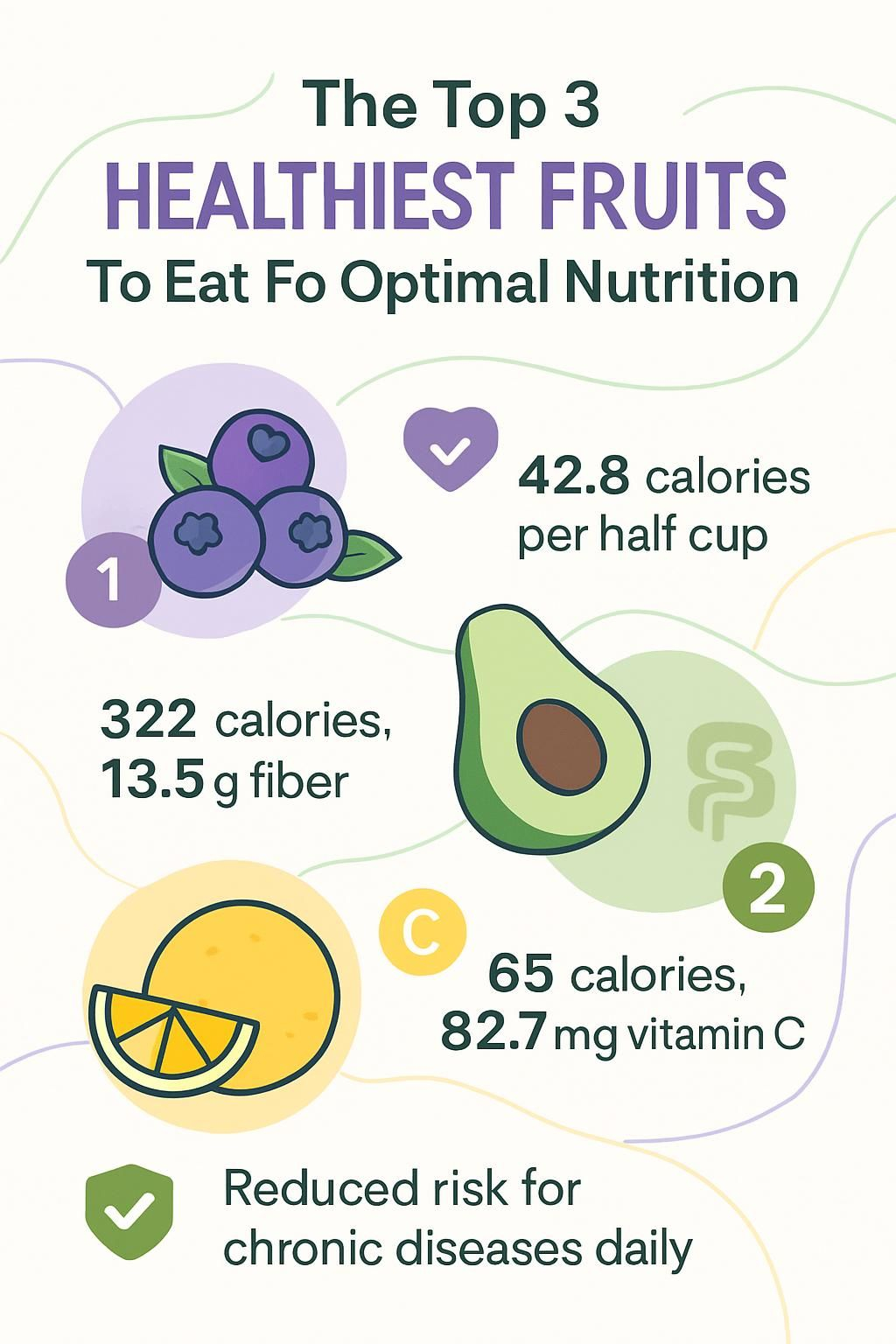The Top 3 Healthiest Fruits To Eat For Optimal Nutrition
Our Nutrition Assistant AI Suite will transform your body. You will lose fat, get toned, and build muscle. Gain confidence and optimal health.
You want a simple plan to eat better, gain steady energy, and protect your health. Choosing a few nutritious fruits makes that easier. Blueberries, avocados, and oranges are top picks because they offer fiber, vitamin C, potassium, healthy fats, and powerful antioxidants.
This guide shows how these fruits support heart health, immunity, digestion, and brain function. You will also learn easy ways to use each fruit every day for optimal nutrition.
Key Takeaways
- Blueberries are low in calories and rich in antioxidants like anthocyanins and pterostilbene, which support brain health and lower inflammation.
- Avocados supply fiber, potassium, and monounsaturated fat, which can lower LDL cholesterol and improve nutrient absorption.
- Oranges provide about 78 percent of the daily value for vitamin C per medium fruit, plus fiber and potassium for immune and skin support.
- Eating a wide variety of fruits, especially these three, may reduce the risk of heart disease, type 2 diabetes, stroke, and obesity.
- Health groups, including the American Heart Association, recommend fruit intake for cardiovascular health as part of a balanced diet.

Why Are Fruits Essential for Optimal Nutrition?

Fruits deliver vitamins, minerals, fiber, and water that your body needs for growth and repair. Diets rich in fruits and vegetables are linked with a lower risk of heart disease and type 2 diabetes. They also add flavor and color to your plate, which makes healthy eating easier to keep up.
What vitamins and minerals do fruits provide?
You get a broad set of nutrients from different fruits. Citrus fruit such as oranges, lemons, and grapefruit supply vitamin C and potassium. One medium banana provides 451 milligrams of potassium, fiber, and vitamin B6, which supports metabolism and nerves.
Avocados stand out for minerals. Each fruit offers about 975 milligrams potassium, 24.1 milligrams calcium, 58.3 milligrams magnesium, and 20.1 milligrams vitamin C. Apples add around 4.37 grams fiber per medium fruit, plus potassium at 195 milligrams and vitamin C at 8.37 milligrams.
Mangoes provide folate, vitamins A and E, vitamin B6, vitamin K, fiber, and potassium. Kiwifruit supports gut health with vitamin C, fiber, folate, and vitamin E. Pineapple delivers close to 70 percent of the daily value for manganese and nearly a full day’s vitamin C per cup, about 165 grams.
Adding a small mix of berries, such as blueberries or blackberries, to oats or yogurt is an easy way to boost your nutrient intake.
How do antioxidants and fiber benefit health?
Antioxidants protect cells from oxidative stress, which is damage caused by unstable molecules. Berries like blueberries, blackberries, and pomegranates rank high in antioxidant compounds. Key groups include anthocyanins, flavonoids such as quercetin, and polyphenols. Anthocyanins give berries their deep color and may lower the risk of heart disease, stroke, and some cancers.
Pomegranate is a strong source of polyphenols that calm inflammation. Fiber supports digestion by adding bulk to stool and keeping bowel movements regular. Soluble fiber helps lower cholesterol, while insoluble fiber supports gut motility. Apples offer both types, including pectin, which acts as a prebiotic that feeds friendly gut bacteria. One cup of blackberries provides about eight grams of fiber.
High fiber foods help you feel full on fewer calories. That can support weight management and steady blood sugar.
How do fruits help prevent diseases?
Eating a variety of fruits each day is linked with a lower risk of heart disease, high blood pressure, and stroke. Berries, including blueberries and strawberries, support cardiovascular health through fiber and antioxidants. A 2020 review noted that pomegranate may help protect against obesity, type 2 diabetes, some cancers, and heart conditions.
Oranges support immune defenses by supplying vitamin C, which also helps you absorb iron from plant foods. Avocados provide monounsaturated fat that is associated with fewer heart attacks and strokes. Mangoes contain mangiferin, a plant compound being studied for brain, heart, and anti-cancer benefits.
One cup of fruit per day, within a balanced diet, raises fiber intake, supports digestion, and may lower the chance of chronic disease as the years pass.
Tips for Choosing the Healthiest Fruits
Smart choices help you reach your daily fruit and vegetable goals. A mix of whole fruit gives you the greatest health benefits.
How can I find nutrient-dense fruits?
Use nutrition labels and reliable databases to spot fruits that deliver more nutrients per calorie. Blueberries and blackberries pack many antioxidants per serving. Guava offers about 140 percent of the daily value for vitamin C in one fruit, plus lycopene and beta carotene, which support immunity and eye health.
Choose whole fruit more often than fruit juice. Most fiber and many nutrients live in the edible parts, not the liquid. Pick color-rich options such as pomegranate, orange, avocado, kiwifruit, dragon fruit, or mango to cover a wide range of plant pigments and benefits.
Include at least one serving of fruit daily as a baseline. Tropical fruits add unique polyphenols that may support healthy blood pressure and lower the risk of type 2 diabetes.
Why choose seasonal and fresh produce?
Seasonal produce is picked closer to peak ripeness, which preserves vitamins and flavor. Fresh choices often contain more vitamin C, thiamine, and beta carotene. In season oranges or blueberries usually taste better and need fewer preservatives. A cup of fresh or frozen blueberries equals a full serving, while dried fruit is concentrated in sugar.
Buying local can also reduce exposure to added sugars or unwanted chemicals. Tools like the MyPlate app help you find fruits in season near you, often at lower prices. Whole oranges beat orange juice for fiber, which supports your gastrointestinal tract and weight goals. I have noticed that local peaches from the farmers market taste sweeter and juicier than off-season options.
How does fruit variety affect nutrition?
Fresh flavor matters, but variety multiplies benefits. Different fruits bring different vitamins, minerals, antioxidants, and phytonutrients. Blueberries provide anthocyanins that protect brain cells. Avocados supply healthy fat for heart health. Oranges are a good source of vitamin C for immune support.
Eating a rainbow of fruits ensures you get various carotenoids and flavonoids. The USDA suggests making at least half your fruit servings whole fruit, not fruit juice. Rotating choices also lowers the chance of missing key nutrients. Pears add soluble fiber for gut health. Watermelon hydrates and offers potassium.
A review found that eating several types of fruit each week may lower the risk of type 2 diabetes more than relying on a single type. Simple swaps, like adding cherries to oatmeal or a squeeze of lime to salads, keep meals interesting and balanced.
The Top 3 Healthiest Fruits to Eat
If you want the biggest health return for your effort, start with the three fruits below. They are simple to find and easy to add to your routine.
Blueberries
Half a cup of blueberries, about 75 grams, has 42.8 calories, 10.9 grams of carbohydrate, and 1.8 grams of fiber. Blueberries are among the highest fruit sources of antioxidants, especially anthocyanins and pterostilbene. These compounds help lower oxidative stress, which can reduce the risk of heart disease, cancer, and stroke.
Blueberries support brain function and may aid memory with regular intake. Try adding them to oatmeal or yogurt for flavor and fiber with very few calories.
What antioxidants are in blueberries?
Blueberries contain anthocyanins, which give the blue-purple color and support blood vessel health. They also offer flavonoids and polyphenols that fight oxidative stress and inflammation. Pterostilbene, a cousin of resveratrol, may help reduce plaque buildup in arteries.
These compounds work together to protect cells from free radical damage. That is one reason blueberries rank high among foods with many antioxidants per serving.
How do blueberries support brain health and reduce inflammation?
Anthocyanins in blueberries protect neurons, which may slow age-related cognitive decline. Studies show regular blueberry intake can support memory and learning in older adults. The polyphenols in blueberries also reduce markers of oxidative stress and improve how brain cells communicate.
I like to add half a cup to morning oats. It keeps the meal light, yet satisfying, and I stay focused through busy hours.
Avocados
Avocados are rich in fiber and healthy fats, which can improve heart and gut health. One 201 gram avocado has about 322 calories, 4.02 grams of protein, and 13.5 grams of fiber. You also get around 975 milligrams of potassium per fruit, which is more than most bananas provide.
Avocados are a strong source of monounsaturated fat, mainly oleic acid, which can lower LDL cholesterol. They also provide folate, vitamin A, beta carotene, and vitamin K.
What healthy fats and fiber are in avocados?
Avocados contain mostly monounsaturated fat, which supports heart health. Each fruit provides around 13.5 grams of fiber, a mix of soluble and insoluble types. Soluble fiber helps lower cholesterol. Insoluble fiber supports regularity and feeds the gut microbiome.
At home, I blend avocado into smoothies or use it on toast. It adds creamy texture without butter or mayonnaise and helps control hunger.
How do avocados promote heart health and nutrient absorption?
Monounsaturated fat in avocado can lower LDL cholesterol and may raise HDL cholesterol. About 975 milligrams of potassium per fruit helps regulate blood pressure. Fiber in avocado contributes to lower cholesterol and steadier digestion.
Avocado fat improves absorption of fat-soluble vitamins A, D, E, and K from other foods you eat with it. Eating avocado regularly is linked with a lower risk of metabolic syndrome and heart disease. After long runs, I like a salad with avocado because it tastes great and helps me refuel.
Oranges
Oranges deliver hydration, vitamin C, and fiber in an easy snack. A medium orange has about 65 calories and 16.5 grams of carbohydrate, plus 2.8 grams of fiber. You also get 82.7 milligrams of vitamin C, about 78 percent of the daily value, along with potassium at 232 milligrams, magnesium at 15 milligrams, calcium at 60.2 milligrams, and B vitamins.
Thanks to vitamin C and antioxidants, oranges support immune defenses and reduce cellular damage. Their water content helps with hydration during busy days or after exercise. They are low in fat and sodium, which fits a heart healthy eating pattern to reduce the risk of heart attack.
What vitamins and minerals are in oranges?
A medium orange supplies 82.7 milligrams of vitamin C for immune support and wound healing. Oranges also provide thiamin and folate, which help your body make energy and red blood cells. Vitamin A supports vision and immune function.
Each orange contains 232 milligrams of potassium to support healthy blood pressure. You also get 60.2 milligrams of calcium for bones and 15 milligrams of magnesium for muscles and nerves. With 16.5 grams of carbohydrate and 2.8 grams of fiber, oranges support steady digestion.
How do oranges boost immunity and improve skin health?
Vitamin C supports the activity of white blood cells, which helps your body fight infection. Oranges also improve iron absorption from plant foods. Their antioxidants neutralize free radicals, which can lower illness risk.
Vitamin C supports collagen, the protein that keeps skin firm and elastic. Antioxidants calm inflammation that can irritate skin. The high water content helps skin stay hydrated. I often snack on orange slices while studying, which gives me energy without added sugar.
What Are the Nutritional Benefits of Each Fruit?
Each fruit brings a distinct package of nutrients. Knowing the specifics helps you match your needs, from vitamin C to fiber to healthy fat.
What key vitamins and minerals come from blueberries?
Blueberries provide vitamin C, vitamin K, and manganese. Half a cup, about 75 grams, supplies 7.28 milligrams vitamin C. That supports your immune system and skin. The same serving gives 4.5 milligrams calcium and 57.8 milligrams potassium for muscle and heart function.
You also get small amounts of magnesium and other micronutrients. Anthocyanins, the dark pigments, add extra antioxidant power. I often sprinkle blueberries over oatmeal to lift fiber and vitamins without adding refined sugar.
What healthy fats and folate are in avocados?
An avocado gets most of its calories from monounsaturated fat, especially oleic acid. This fat supports heart health and may lower LDL cholesterol. One fruit provides about 322 calories and 13.5 grams of fiber.
Avocados are a rich source of folate, which supports cell growth and repair. They also supply vitamin A, beta carotene, lutein, and zeaxanthin for eye health. Each fruit contains about 58.3 milligrams magnesium and 24.1 milligrams calcium.
How many antioxidants do oranges contain?
Oranges are antioxidant rich because they provide vitamin C, flavonoids, and carotenoids. A medium orange supplies 82.7 milligrams of vitamin C. Flavonoids are plant compounds that help protect cells and may support healthy blood sugar.
Carotenoids add further antioxidant support. Together with B vitamins, these compounds help neutralize free radicals that damage cells. This combination supports immunity and skin wellness.
How Does Eating These Fruits Improve Your Health?
Blueberries, avocados, and oranges support many body systems. Research shows that eating a range of fruits helps protect long term health.
How do these fruits reduce chronic disease risk?
Blueberry anthocyanins support blood vessel function and heart health. Studies link higher berry intake with fewer strokes and better cardiovascular markers. A 2024 review found that daily pomegranate juice, about 250 milliliters, lowered inflammation markers tied to chronic illness.
Avocados provide monounsaturated fat that is associated with a lower risk of heart disease and stroke. They also help you absorb nutrients from vegetables. Oranges deliver vitamin C and other antioxidants that support the cardiovascular system and immunity.
People who often eat fruit, including grapefruit and berries, tend to have lower body weight and healthier cholesterol patterns in population studies. A Mediterranean style diet that is rich in fruits may also lower the risk of obesity and cognitive decline.
How do they improve digestion and gut health?
Avocados add 13.5 grams of fiber per fruit, which supports bowel regularity and feeds beneficial gut bacteria. Apples provide pectin, a soluble fiber that acts as a prebiotic to nourish the microbiome. Bananas offer 3.28 grams of fiber in a medium fruit and contain resistant starch, which also feeds gut bacteria.
Kiwifruit has been shown to increase stool frequency and soften stools when eaten daily. Pineapple contains bromelain, an enzyme that helps break down proteins after meals. Many berries and mangoes add extra fiber, which helps digestion run smoothly.
How do these fruits enhance immune function?
Blueberries supply antioxidants that reduce oxidative stress on immune cells. Oranges provide 82.7 milligrams of vitamin C per medium fruit, which supports your body’s defenses. Grapefruit offers about 48 milligrams vitamin C per half fruit. Guava delivers even more vitamin C, roughly 140 percent of the daily value per fruit.
Strawberries and pineapple also contribute high vitamin C per serving. Lemons and blackberries add smaller amounts, yet they still support daily needs when included regularly.
Can these fruits support weight management?
Fruits can help you manage weight by adding fiber and water with relatively few calories. Avocados are higher in calories, but their healthy fats and fiber improve fullness and may reduce snacking later. Strawberries are low in calories, about 48 per cup, and have high water content, which helps you feel satisfied.
Apples provide about 4.37 grams of fiber per medium fruit, which supports fullness. Grapefruit intake has been linked with lower body mass index in observational research. Watermelon is hydrating and low in calories, which can help control total intake.
Adding blueberries to breakfast helped me avoid mid-morning sweets. Choosing whole fruit with meals improves energy steadiness and reduces cravings for processed snacks.
How Can You Incorporate These Fruits into Your Meals?
Simple habits work best. Pair these fruits with staple foods you already enjoy so they become a natural part of your day.
How to add blueberries to smoothies or oatmeal?
Blend one cup, about 150 grams, of fresh or frozen blueberries into a smoothie for a full fruit serving. This boosts antioxidants without added sugar. For oatmeal, stir in half a cup during cooking or sprinkle on top. That adds fiber and vitamin C.
Blueberries also pair well with yogurt, chia pudding, or whole grain cereal. Dried blueberries are more concentrated in sugar, so use a small portion. A serving of fresh blueberries has 42.8 calories and 1.8 grams of fiber, which supports gut health.
How to use avocados in salads, sandwiches, or spreads?
Add avocado slices to salads with leafy greens and tomatoes for extra fiber and healthy fats. One avocado provides 322 calories and 13.5 grams of fiber, which makes salads more filling. Toss diced avocado with lime juice on wraps or grain bowls to improve nutrient absorption from vegetables.
Mash avocado as a spread on toast or sandwiches instead of mayonnaise. Make simple guacamole with avocado, lime, and a pinch of salt. Avocado pairs well with eggs, whole grain crackers, and even sushi rolls for a creamy, satisfying bite.
How to enjoy oranges as a snack or juice?
Eat oranges as a portable snack. One medium fruit counts as a 1 cup fruit serving and supplies about 82.7 milligrams of vitamin C. Add segments to salads for a bright citrus note. Layer chopped orange in yogurt parfaits or fruit salads for a refreshing breakfast.
If you drink juice, squeeze your own and limit the portion. One cup of 100 percent orange juice can fit into your day, but it lacks fiber compared with whole fruit. Use zest to add flavor to baked goods or to roasted vegetables.
Other Nutrient-Rich Fruits to Consider
Aim for variety through the week. These options add extra nutrients and color to your plate.
What nutrients do strawberries provide?
One cup of strawberries, about 150 grams, has 48 calories and 3 grams of fiber, plus 88.2 milligrams of vitamin C. You also get calcium at 24 milligrams, magnesium at 19.5 milligrams, and potassium at 230 milligrams. Strawberries supply B vitamins, vitamin A, and vitamin K.
Bright red color signals anthocyanins, which fight free radicals. Strawberries have a low glycemic index, which helps with steady blood sugar. High water content also supports hydration on warm days.
How do bananas benefit potassium levels and energy?
Bananas support fluid balance and blood pressure with 451 milligrams potassium per medium fruit. Potassium also helps muscles contract and nerves function. Each banana provides about 112 calories and 28.8 grams carbohydrate for quick energy.
Bananas add 3.28 grams of fiber for digestion and small amounts of protein, calcium, magnesium, and vitamin C. They are convenient on the go or sliced over oats and yogurt.
What antioxidants and heart benefits come from pomegranates?
Pomegranates provide many polyphenols that reduce oxidative stress and inflammation. They also deliver fiber, potassium, vitamin C, and vitamin K. Regular intake is linked with lower blood pressure and healthier cholesterol patterns.
I enjoy sprinkling pomegranate seeds over salads or oatmeal for a juicy, tangy crunch and a boost to heart health.
What Are Common Myths About Fruits and Nutrition?
Myths about sugar and serving sizes can keep you from eating fruit. Here are clear facts to guide your choices.
Are fruits too high in sugar?
Fruits contain natural sugars, but they come with fiber, vitamins, and minerals. Fiber slows how fast sugar enters your bloodstream. Many fruits have a low or moderate glycemic index compared with sweet snacks or sodas.
Research suggests that people who eat fruit regularly tend to have lower rates of obesity and diabetes than those who avoid fruit. Choosing whole fruit supports health through prebiotic fiber and antioxidants.
Is it possible to eat too much fruit?
Yes. Very large amounts can raise sugar and calorie intake. Balance matters, especially if you monitor blood sugar or manage weight. Higher calorie fruits like avocados are healthy, but portions still count.
Pick nutrient-dense options and aim for variety. The American Heart Association encourages a balanced approach to added sugars and total calories. If you have a medical condition, ask a healthcare professional about your ideal fruit intake.
Conclusion
Blueberries, avocados, and oranges make a powerful trio. Each one delivers unique nutrients for heart health, brain support, digestion, and strong immunity. Blueberries offer anthocyanins that protect cells. Avocados provide fiber and monounsaturated fat for cholesterol control and better nutrient absorption. Oranges supply vitamin C for immune and skin health.
Choose these three often, then add variety through the week with other fruits. Small daily habits, like a cup of fruit at breakfast, can reduce the risk of chronic disease and keep your energy steady. For personal medical advice, consult a registered dietitian or your clinician.
Sources: USDA FoodData Central; American Heart Association; peer reviewed studies including 2020 and 2024 systematic reviews on fruit intake and cardiometabolic health.
FAQs
1. Which fruits are considered the top three healthiest for optimal nutrition?
Blueberries, kiwi fruit, and lime fruit rank among the healthiest choices. Blueberries provide antioxidants that help reduce radical chemistry damage in cells. Kiwi contains high vitamin C and acts as a prebiotic by supporting gut health. Lime fruit offers vitamin C and can enhance iron absorption.
2. How does eating these fruits support digestive health?
Kiwi serves as a natural prebiotic, feeding beneficial gut bacteria to improve digestion. Lime fruit also aids digestion due to its acidic nature, which helps break down food more efficiently.
3. Are there any unique nutrients or compounds found in these fruits?
Yes; blueberries contain anthocyanins that fight oxidative stress caused by free radicals in chemistry processes within the body. Kiwi is rich in fiber and vitamin E while lime provides flavonoids with antioxidant properties.
4. Can combining these fruits with other foods increase their nutritional benefits?
Pairing lime juice with leafy greens or mustard condiment can boost iron absorption from plant sources due to the citrus acid content of limes; this combination supports better nutrient uptake according to recent studies on human nutrition.
Summary: Blueberries, kiwi fruit, and lime offer strong nutritional value through antioxidants, vitamins, prebiotics, and improved mineral absorption when combined thoughtfully with other foods such as mustard condiment or leafy vegetables.







